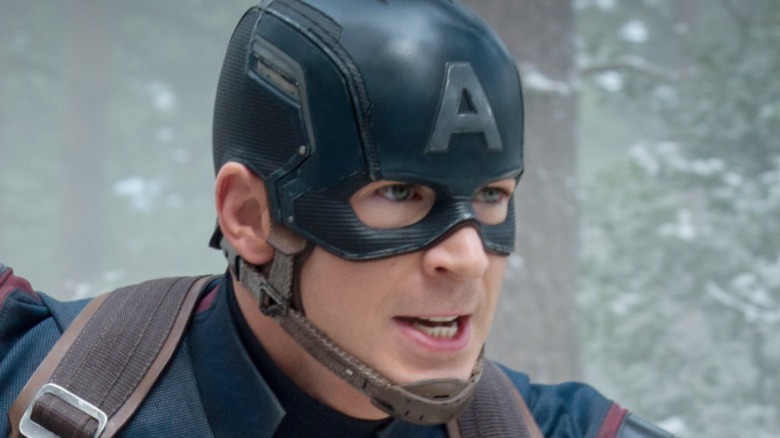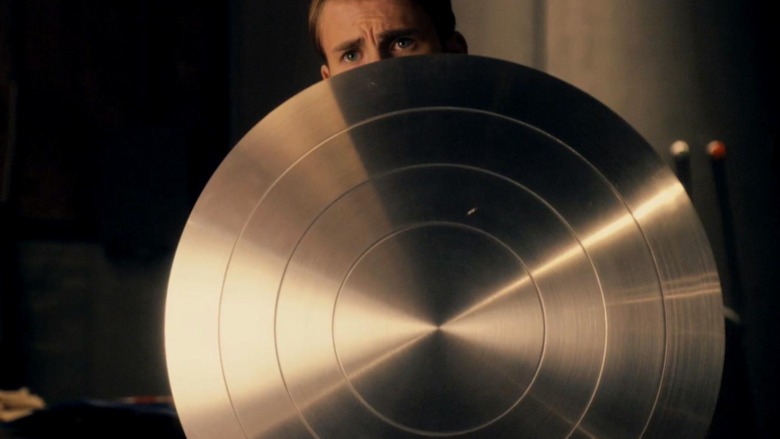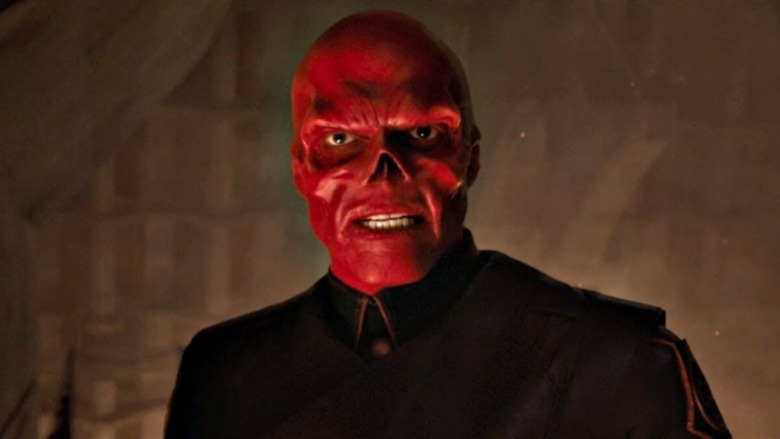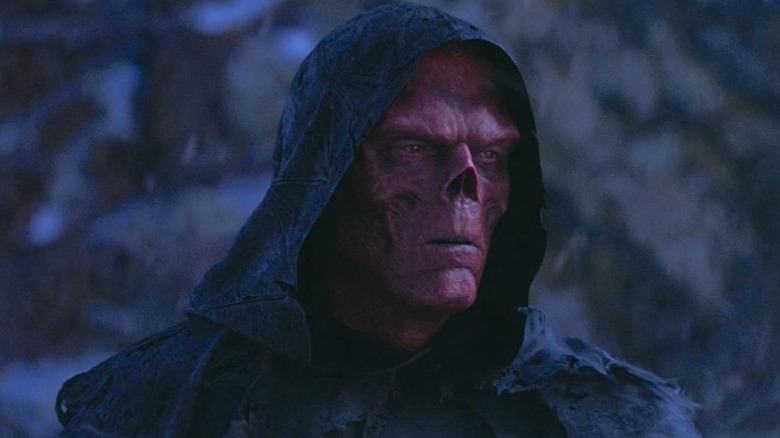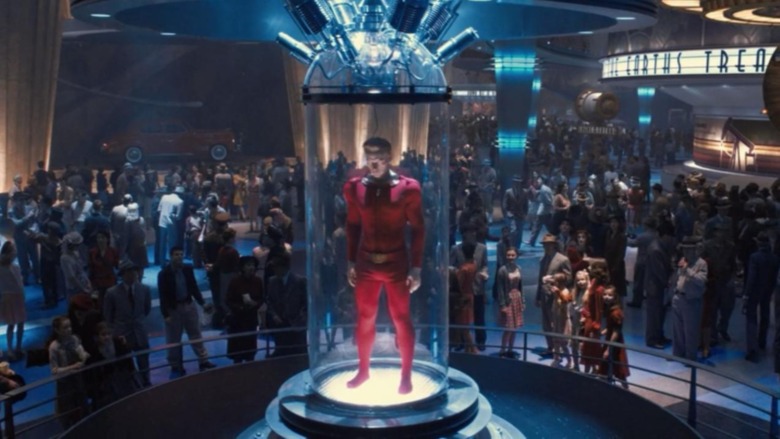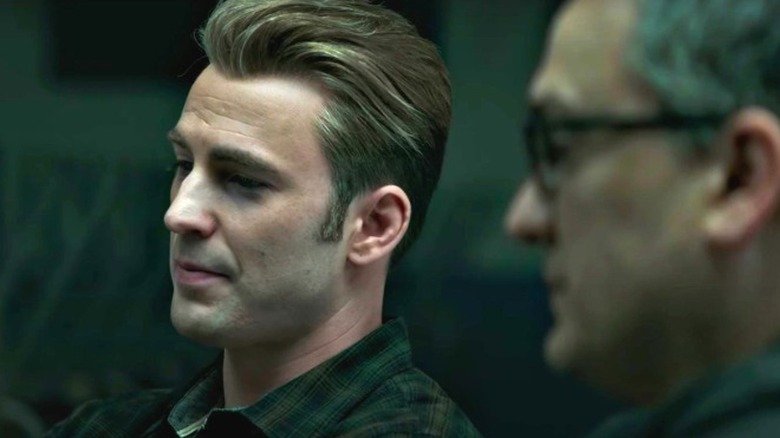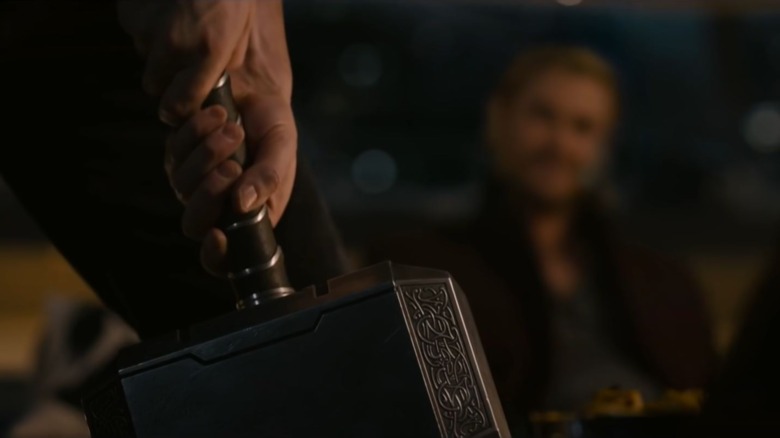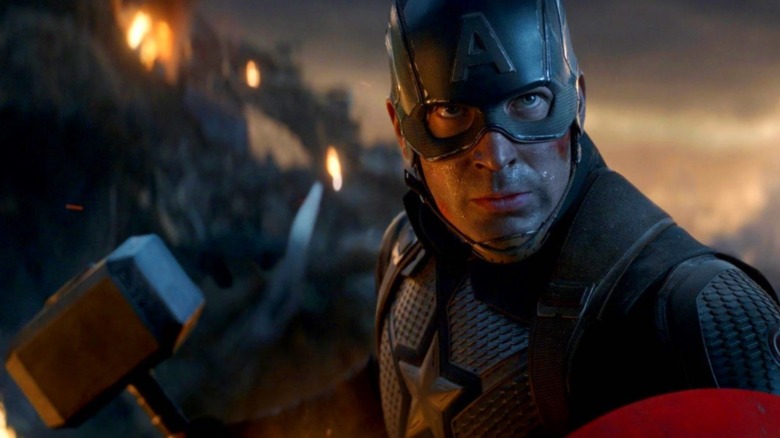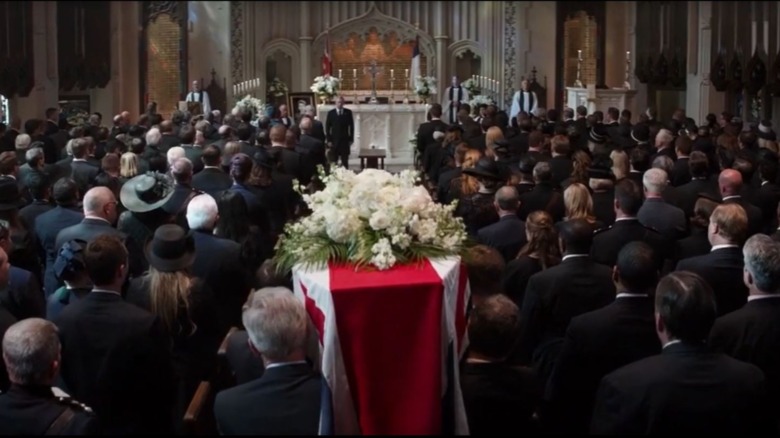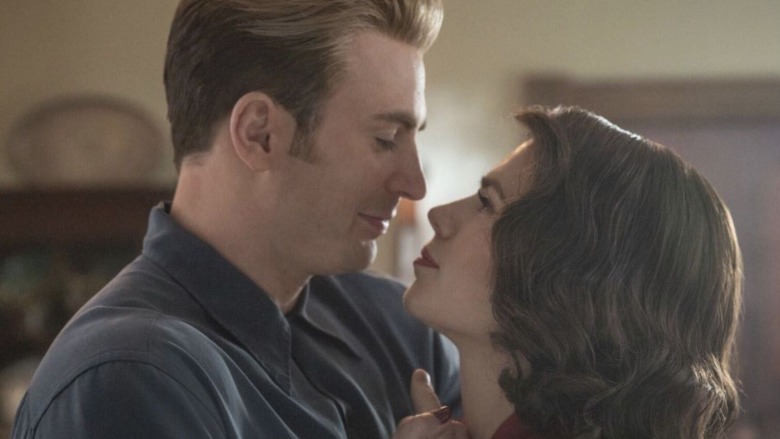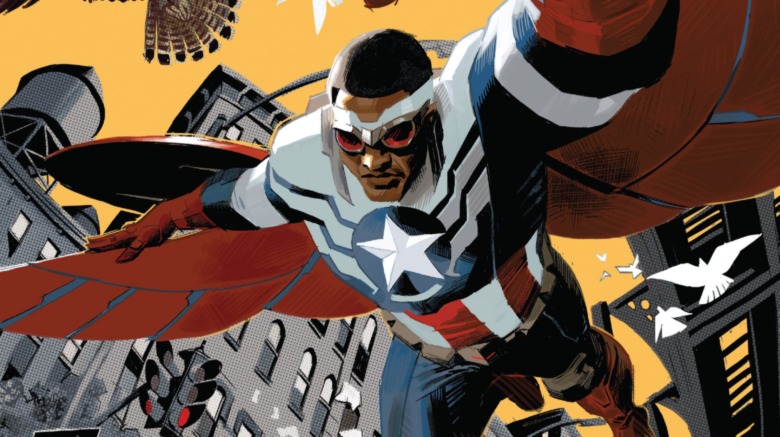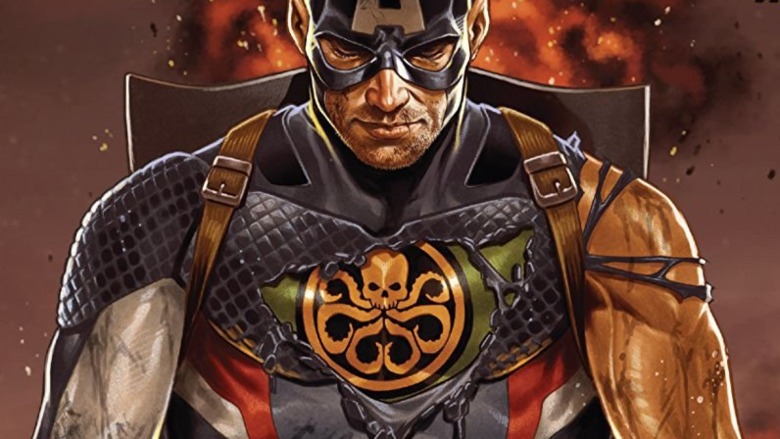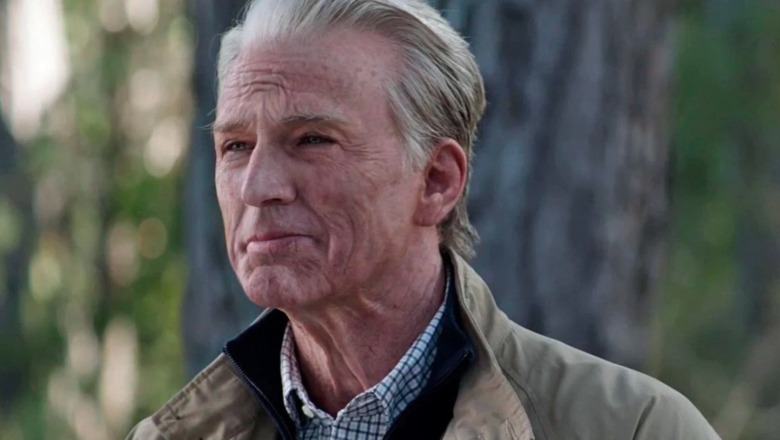Captain America Theories That Change Everything
In 2011, Chris Evans leapt onto the screen for the first time as "Captain America: The First Avenger," and in 2019's "Endgame," his eight year journey as Steve Rogers finally came to an end. With Thanos defeated and nearly everyone he killed restored to life, Rogers chose to stay in the past and live out the rest of his days with Peggy Carter, the love of his life, only returning to give Sam Wilson his famous shield and hope that he would continue his legacy in "The Falcon and the Winter Soldier."
But despite the fact that Captain America's story in the Marvel Cinematic Universe seems to have come to a close, there is still plenty to talk about: plot-holes that haven't been filled, details that were never explained, and debates that will likely rage until the end of time. With that in mind, here are some Captain America theories that could change everything.
Cap's Vibranium shield isn't his only connection to Wakanda
In "Captain America: The First Avenger," Steve got his famous, indestructible shield from Howard Stark as he was gearing up to become Captain America officially for the first time. The shield is made from pure vibranium, a valuable and powerful metal that absorbs kinetic energy and can only be found in the isolationist nation of Wakanda.
Though it's unknown how Howard Stark or the US government acquired the vibranium, many theorize that this isn't the only resource from Wakanda that contributed to Captain America's origin. In 2018's "Black Panther," T'Challa had to find and consume the purple "Heart-Shaped Herb" that gave the rulers of Wakanda the enhanced abilities they used to become the Black Panther.
If the US government — or at least at least Stark — had access to enough vibranium to create a shield out of the material, it is also possible that they had access to the heart-shaped herb. The theory, once suggested by Reddit user 4DimensionalToilet, proposes that the herb was used by Dr. Erskine as a part of his Super Soldier Formula. If this is the case, it could help explain why it proved so difficult to recreate the formula after Erskine's death. If they didn't have any more of the herb, then trying to replace it in the formula would not be an easy task.
Penicillin kept Steve from becoming another Red Skull
During Steve Roger's transformation sequence in "Captain America: The First Avenger," one of the many doctors in the room injects Steve with a long syringe. Afterwards, Rogers remarks that this "wasn't so bad," and the doctor informs him that this was not the super soldier formula but was rather simply penicillin.
Though the scene is played for laughs, some theorize that this moment is actually far more important than the movie lets on. Later on in the film, Steve finally comes face to face with his arch-nemesis, the Red Skull. Rogers discovers that the villain has also been given a version of the Super Soldier formula, but that his injection went horribly wrong — and though it did give him enhanced abilities, it also radically deformed his face.
According to the theory, the difference between Captain America and the Red Skull's experiences with the formula may have come down to the penicillin. Reddit user rafael-a postulates that the super soldier serum would likely enhance the multitude of bacteria that are always present within our body and that the penicillin shot was necessary to keep those enhanced microbes from creating any undesirable side-affects. If Red Skull wasn't given a penicillin shot, then this might be why his appearance was so incredibly altered.
Steve met Red Skull when he returned the soul stone
At the end of "Captain America: The First Avenger," the Red Skull is finally defeated by Steve Rogers when the Tesseract (secretly the housing for one of the Infinity Stones) opens up a wormhole that flings the villain out into the cosmos. Viewers wouldn't find out where he landed for another seven years when "Avengers: Infinity War" finally revealed that he had been transported to the planet Vormir and been transformed into the guardian of the Soul Stone.
Thanos, Gamora, Hawkeye, and Black Widow all met the villain when they sought to acquire the Soul Stone for their differing missions, but something that the movie doesn't address is this: when Captain America returns all of the Infinity Stones to their correct location in the timeline, did he meet the Red Skull again while returning the Soul Stone? Many fans (and common sense) declare that the answer to this question is a resounding "yes." The possible reunion of these two enemies has captured the imaginations of many viewers ever since. Indeed, the Russos confirmed during a Reddit AMA that such a meeting occurred, but "It was probably more awkward than you imagine it was. Red Skull felt slated because Cap didn't recognize him."
The Avengers weren't Cap's first superhero team
In "Captain America: The First Avenger," Steve Rogers and Bucky Barnes spend Bucky's last night as a civilian by going to the 1943 "World Exposition of Tomorrow," a fair meant to celebrate and showcase the latest and greatest scientific achievements. One of the many items on display is one of the best Captain America Easter eggs in the MCU: the original Human Torch.
Created by a scientist named Phineas Horton, the original Human Torch first appeared in 1939's Marvel Comics #1. He had no relation to the famous Fantastic Four but was instead an android with the ability to combust into flame, fly, and use fire in combat. Adopting the name "James Hammond," the Torch would eventually fight against the Nazis in World War II and join one of the first superhero teams ever formed in the Marvel Comics Universe: The Invaders.
The Invaders were a group of superheroes who banded together to fight in the European theater of WWII and were comprised of the Human Torch, his partner Toro, Namor the Submariner, Union Jack, Bucky Barnes, and Captain America. Though "just" an Easter egg, the Torch's appearance confirms that he exists in the MCU, and it means that it's possible that the Howling Commandos weren't the only team that Cap lead — or even just fought alongside — during the war. He might also have lead the Invaders as well.
Steve became a counselor in Endgame to honor Sam
After the unprecedented and heart-breaking events of 2018's "Avengers: Infinity War," Steve Rogers was left to mourn the loss of two of his closest friends, Sam Wilson and Bucky Barnes. In a world bereft of half of its population, there were an endless number of ways that a super soldier like Steve could use his many abilities to help, but when "Avengers: Endgame" released in 2019, viewers discovered that he had chosen to become a group counselor.
Though it might seem like an odd choice at first, Reddit user windmillninja pointed out that this was likely a decision that Steve made to honor the death of Sam Wilson. When Steve first met Sam in "Captain America: The Winter Soldier," Sam was working as a counselor for veterans. A veteran himself, Sam wanted to help others work through the issues that he himself had suffered from when he rejoined civilian life.
The fact that Steve Rogers chose to do the same thing in Endgame was likely Steve's way of honoring Sam Wilson's legacy, and this choice shows just how much Steve respected Sam and makes his decision to give Sam the shield at the end of the movie even more poignant. Before Steve asked Sam to take up the legacy of Captain America that he was leaving behind, Steve had already taken up the mantle that Sam had left behind after the snap.
Steve could have lifted Thor's Hammer in Avengers 2
One of the most famous scenes in "Avengers: Age of Ultron" shows the Avengers hanging out at Avengers Tower in New York City after yet another mission battling Hydra. After a few drinks, the Avengers decide to all take turns trying to lift Thor's famous hammer, Mjolnir. It can only be lifted by those who are worthy of its power. Each Avenger fails to lift the hammer, but something interesting happens when Steve tries: it moves just an inch before returning to its normal, unliftable state.
The moment clearly makes Thor nervous, as he didn't expect anyone on the team to be able to lift it, and quickly declares that his teammates are "all not worthy," but many fans think that Thor was wrong. It's possible that Steve was already fully capable of lifting the hammer in that moment but instead chose not to and pretended to fail like everybody else.
The reasons why he chose not to lift the hammer vary. Some claim he did it out of modesty. He didn't want to show off or upstage his teammates; he saw how nervous it made Thor and thus pretended that he couldn't lift it in order to put him at ease. Others claim that he did it because he knew that power can corrupt, and that his decision not to lift the hammer was part of why he was worthy of it in the first place.
Steve wasn't able to lift Thor's hammer till Endgame
In "Avengers: Endgame," Steve Rogers finally gave fans what they had been waiting for since "Age of Ultron" and lifted Thor's famous hammer, Mjolnir. Though many viewers believe that Steve was always capable of this feat, many others disagree and state that Steve was not capable of doing this until well after the second Avengers film.
Some argue Steve was almost able to lift it in "Ultron" because he was almost worthy of it but he still had several flaws that he needed to work out in order to finally lift it in "Endgame." Though the idea that Steve was always worthy is appealing, the idea that he wasn't until after "Age of Ultron" seems to line up better with what viewers are actually shown on screen.
When the hammer scene in the second Avengers movie plays, Steve still has several beats in his character arc to hit. He still needs to learn that he isn't nothing without a war to fight; he still needs to grow from the events of "Civil War" and "Infinity War," and with a five year gap before he lifts the hammer in "Endgame," it's quite likely that his time as a counselor helped Steve finally achieve the standard Mjolnir was looking for. Even franchise creatives disagree about when, where, and why Steve was able to lift Mjolnir, leaving plenty of room for theory and interpretation.
Steve was Peggy's mystery husband the entire time
In "Captain America: The First Avenger," Steve Rogers and Peggy Carter fall in love before Steve is lost for decades in the ice. In "the Winter Soldier," Steve meets Peggy as an old woman for the first time and learns about her husband, and in "Civil War," he attends her funeral, but viewers never find out who Peggy's husband actually was.
Thanks to the events of "Avengers: Endgame," however, many fans now believe that Peggy's mysterious husband was actually Steve Rogers all along. During the film's time travel sequence, Steve sees Peggy once again and, once his task is complete, he decides to stay in the past and live out his days with his life-long love.
Because of this development, some fans now believe that Peggy's account about her husband was actually about Steve. She states that during World War II, Captain America saved both herself and number of other soldiers, including the man that would become her husband. Though the way it's worded definitely implies that Cap and her husband are two different people, it's entirely possible that this was simply word-play used to keep the timeline intact.
Screenwriter Stephen McFeely endorses this theory, saying in an interview with Canada.com that he's "partial to the idea that Steve is part of a strange, unique time-loop where he has always been there. ... To be fair, not everyone agrees with us. I don't even know if Marvel agrees with us. But that's what we think."
Steve was actually in an alternate timeline
Many fans love the idea that Steve was Peggy's husband all along, but the theory does have one major flaw. In addition to the weird idea that Steve lived through the events of the MCU twice without ever interfering, "Avengers: Endgame" itself states that changing history using time travel is more likely to create an alternate universe than to actually alter history.
Avoiding the creation of an alternate "branch" timeline is the reason why Steve has to return the Infinity Stones to their proper place in history in the first place, and many fans believe that by staying in the past, Steve inevitably created a new branch. According to the theory, Steve's decision didn't affect the MCU's history because he was living in a new branch all along, only returning to give Sam the shield.
This theory isn't perfect either, however. How does he create the branch while returning to the main timeline? Additionally, "Endgame" establishes that it's possible to change history without creating a branch, so it's entirely possible that Steve simply kept a low profile and avoided interfering with history entirely. There is no reason why Steve returning to the past has to create a new timeline. Unfortunately for fans however, they won't receive an answer to this question from the film's creators, as its writers and directors don't agree on which theory is correct either.
Sam Wilson was already Captain America before The Falcon and the Winter Soldier
Despite its issues, the idea that Steve created an alternate timeline by living out his days with Peggy does provide an explanation for one other detail. At the end of "Endgame," Steve gives Sam Wilson the mighty shield of Captain America even though the shield was destroyed earlier in the movie. Viewers never saw it rebuilt, but Steve has it anyway without explanation.
Reddit user smacksaw has one possible answer: the shield that Steve gave to Sam was from the alternate timeline he had been living in. In that world, it's entirely possible that the shield was never destroyed, and the new design details on the shield viewers see in "The Falcon and the Winter Soldier" could lend credence to this idea.
The Reddit user takes the theory one step further, however, and postulates that if the shield was from another timeline, it's possible that the shield had already belonged to that timeline's version of Sam Wilson. This is primarily derived from three lines of dialogue: Steve asks Sam how the shield feels, Sam replies that it feels "like it's someone else's," and Steve states that "it isn't." Though a simpler explanation is that Steve is merely reinforcing the idea that it now belongs to Sam, the Reddit user proposes that fans might need to take it more literally.
Endgame set up the Hydra Captain America
During "Avengers: Endgame," Steve must tells a group of SHIELD agents to "hail Hydra" in order to retrieve the mind stone-powered scepter from the first "Avengers" movie. When his past self spots him, he poses as Loki to fight him and eventually defeats him using the scepter. Though both clever and humorous in context, the "hail Hydra" moment also functions as a reference to then-recent events in Marvel Comics, where Captain America had recently been revealed to be a Hydra sleeper agent.
Though the moment seems to poke fun at the idea, some fans theorize that it could be a sign of what's to come. The "Hydra Captain America" in the comics was eventually revealed to be a version of Steve Rogers from an alternate universe who was eventually defeated by Sam Wilson (who was Captain America at the time) with the help of the real Steve Rogers when he finally returned.
Combined with the "Endgame" concept of branching timelines and the upcoming film "Doctor Strange in the Multiverse of Madness," it's quite possible that Steve's actions in Endgame might have created both a branching timeline and the Hydra Captain America from the comics. Though likely flawed and a little convoluted, using the scepter on himself could have destabilized that branch's Steve Rogers sanity enough for the SHIELD agents to capitalize on the idea the real Steve planted in order to get the scepter in the first place.
Captain America is the old man on the moon
One of the most pressing questions left by "Endgame" is the fate of the elderly Steve Rogers. "The Falcon and the Winter Soldier" hasn't addressed this question either. Though they mention that Steve is "gone," the answer seems purposefully vague and could mean any number of things. Steve might be dead, having passed away due to old age in between the movie and the television series. He might have returned to the alternate timeline where he lived with Peggy after giving Sam the shield, though fans can't agree if there even is an alternate timeline to return to.
The show's first episode proposed a different idea, however, when Torres asks Sam what happened to Steve and mentions that there are rumors that Steve is on some hidden space bunker on the moon. Sam tells Torres not to believe everything he hears, and, this idea could be easily dismissed if not for two facts. However, Sam doesn't explicitly deny the rumor. Maybe Torres' rumor isn't as preposterous as it seems.
